|
| Mosaic Home |
 |
 |
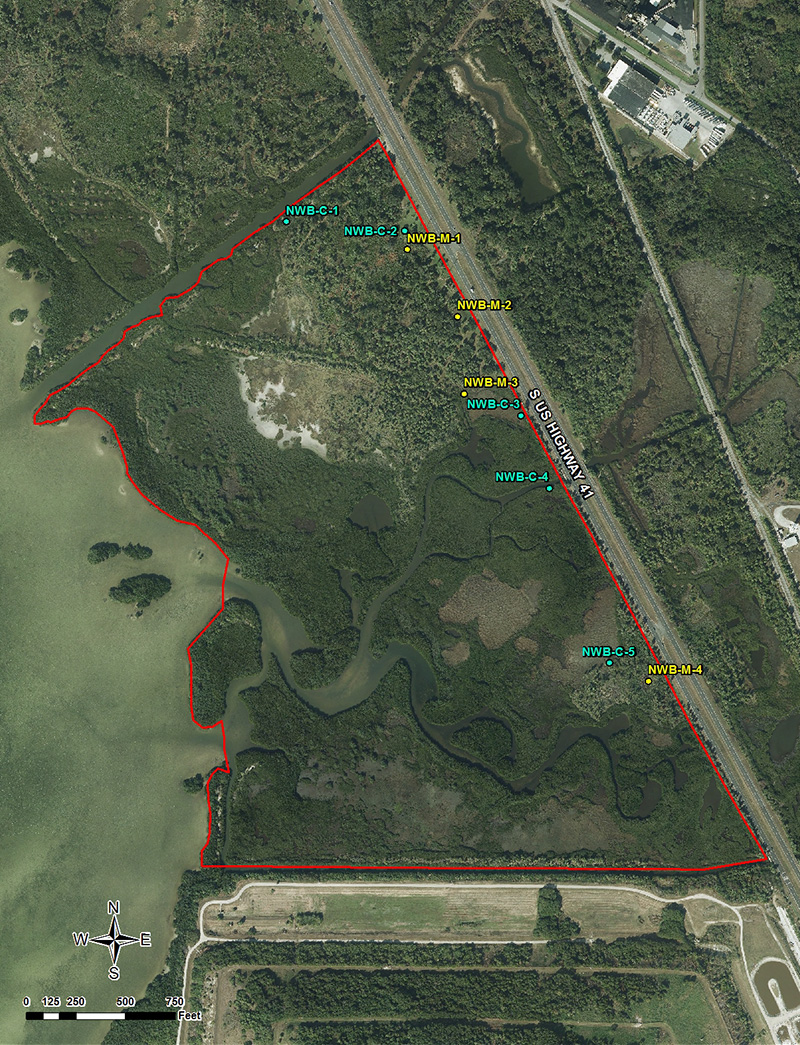 |
| 2024 Monitoring Photographs: North Parcel West B
View: 2006 | 2007 | 2008 | 2009 | 2010 | 2011 | 2012 | 2013 | 2014 | 2015 | 2016 | 2017 | 2018 | 2019 | 2020 | 2021 | 2022 | 2023 | 2024
| NWB-M-1 |
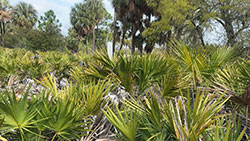 |
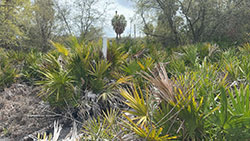 |
| North - 2/29/2024: Monitoring Station NWB - M-1 facing north toward saw palmetto (Serenoa repens) prairie with scattered cabbage palm (Sabal palmetto). Herbaceous species include chalky bluestem (Andropogon virginicus var. glaucus) and smutgrass (Sporobolus indicus).
|
East - 2/29/2024: Monitoring Station NWB - M-1 facing east toward saw palmetto (Serenoa repens) prairie containing scattered cabbage palm (Sabal palmetto) and live oak (Quercus virginiana). Winged sumac (Rhus copallinum) and chalky bluestem (Andropogon virginicus var. glaucus) are present throughout. US 41 can be seen in the background.
|
| |
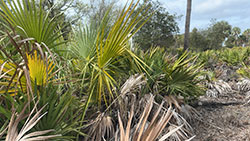 |
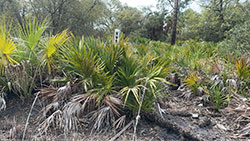 |
| West - 2/29/2024: Monitoring Station NWB - M-1 facing west toward saw palmetto (Serenoa repens) prairie containing scattered cabbage palm (Sabal palmetto), live oak (Quercus virginiana), and chalky bluestem (Andropogon virginicus var. glaucus).
|
South - 2/29/2024: Monitoring Station NWB - M-1 facing south toward saw palmetto (Serenoa repens) prairie. Live oak (Quercus virginiana), winged sumac (Rhus copallinum), and cabbage palm (Sabal palmetto) are present throughout, along with two, long leaf pines (Pinus palustris).
|
| NWB-M-2 |
 |
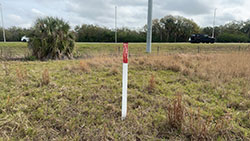 |
| North - 2/29/2024: Monitoring Station NWB - M-2 facing north toward cabbage palm (Sabal palmetto) and live oak (Quercus virginiana). Various mown grasses such as bermudagrass (Cynodon dactylon), pinewoods fingergrass (Eustachys petraea), bahiagrass (Paspalum notatum), purple bluestem (Andropogon glomeratus var. glaucopsis), smutgrass (Sporobolus indicus), and needle rush (Juncus roemerianus) dominate the groundcover.
|
East - 2/29/2024: Monitoring Station NWB - M-2 facing east toward maintained grass species dominated by bermudagrass (Cynodon dactylon), pinewoods fingergrass (Eustachys petraea), bahiagrass (Paspalum notatum), purple bluestem (Andropogon glomeratus var. glaucopsis), smutgrass (Sporobolus indicus), and needle rush (Juncus roemerianus).
|
| |
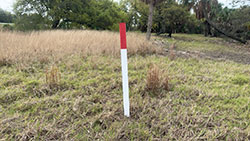 |
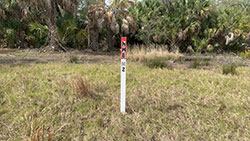 |
| West - 2/29/2024: Monitoring Station NWB - M-2 facing west toward live oak (Quercus virginiana), cabbage palm (Sabal palmetto), and saw palmetto (Serenoa repens). Various mown grasses such as bermudagrass (Cynodon dactylon), pinewoods fingergrass (Eustachys petraea), bahiagrass (Paspalum notatum), purple bluestem (Andropogon glomeratus var. glaucopsis), smutgrass (Sporobolus indicus), and needle rush (Juncus roemerianus) dominate the ground cover.
|
South - 2/29/2024: Monitoring Station NWB - M-2 facing south toward cabbage palm (Sabal palmetto) and oaks (Quercus sp.) with various grass species including bermudagrass (Cynodon dactylon), pinewoods fingergrass (Eustachys petraea), bahiagrass (Paspalum notatum), purple bluestem (Andropogon glomeratus var. glaucopsis), smutgrass (Sporobolus indicus), and needle rush (Juncus roemerianus). This area is primarily maintained by mowing.
|
| NWB-M-3 |
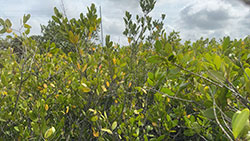 |
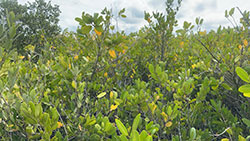 |
| North - 2/29/2024: Monitoring Station NWB - M-3 facing north toward black mangrove (Avicennia germinans), white mangrove (Laguncularia racemosa), saltmeadow cordgrass (Spartina patens), saltgrass (Distichlis spicata), and needle rush (Juncus roemerianus). Some bushy bluestem (Andropogon glomeratus), Brazilian pepper (Schinus terebinthifolia) seedlings, and cabbage palm (Sabal palmetto) are present along the wetland edge.
|
East - 2/29/2024: Monitoring Station NWB - M-3 facing east toward white mangroves (Laguncularia racemosa), black mangroves (Avicennia germinans), saltgrass (Distichlis spicata), needle rush (Juncus roemerianus), saltmeadow cordgrass (Spartina patens), with scattered cabbage palm (Sabal palmetto) at the wetland edge.
|
| |
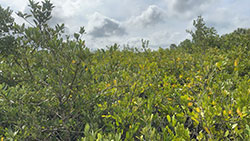 |
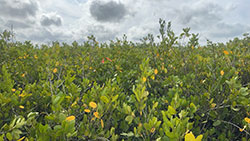 |
| West - 2/29/2024: Monitoring Station NWB - M-3 facing west toward black mangroves (Avicennia germinans) and white mangroves (Laguncularia racemosa), with cabbage palm (Sabal palmetto), bigleaf sumpweed (Iva frutescens), and live oak (Quercus virginiana) at the upland edge. Other identified species include scattered long leaf pine (Pinus palustris).
|
South - 2/29/2024: Monitoring Station NWB - M-3 facing south into a salt marsh dominated by mangroves. Other species present include needle rush (Juncus roemerianus) and saltmeadow cordgrass (Spartina patens).
|
| NWB-M-4 |
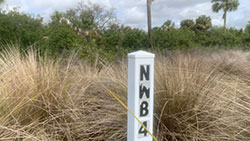 |
 |
| North - 2/29/2024: Monitoring Station NWB - M-4 facing north toward sand cordgrass (Spartina bakeri), saltwater falsewillow (Baccharis angustifolia), bigleaf sumpweed (Iva frutescens), cabbage palm (Sabal palmetto), sea blite (Suaeda linearis), needle rush (Juncus roemerianus), and black mangrove (Avicennia germinans) with some Brazilian pepper (Schinus terebinthifolia).
|
East - 2/29/2024: Monitoring Station NWB - M-4 facing east toward sand cordgrass (Spartina bakeri), sea blite (Suaeda linearis), bigleaf sumpweed (Iva frutescens), cabbage palm (Sabal palmetto), and scattered Brazilian pepper (Schinus terebinthifolia). US 41 can be seen in the background.
|
| |
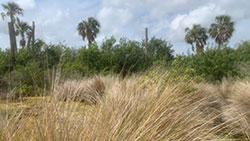 |
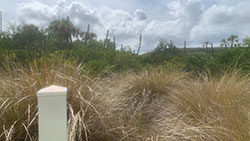 |
| West - 2/29/2024: Monitoring Station NWB - M-4 facing west toward mangroves. Other species include saltwater falsewillow (Baccharis angustifolia), bigleaf sumpweed (Iva frutescens), cabbage palm (Sabal palmetto), and sand cordgrass (Spartina bakeri).
|
South - 2/29/2024: Monitoring Station NWB - M-4 facing south toward white mangroves (Laguncularia racemosa), sand cordgrass (Spartina bakeri), bigleaf sumpweed (Iva frutescens), and cabbage palm (Sabal palmetto).
|
|
|
|
|
